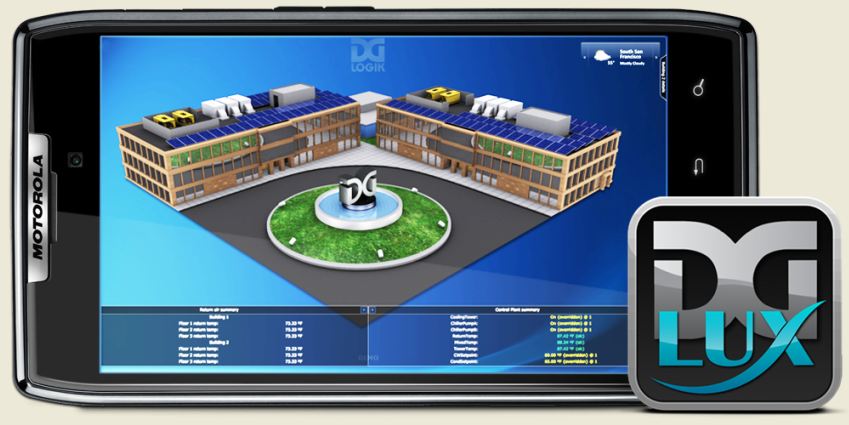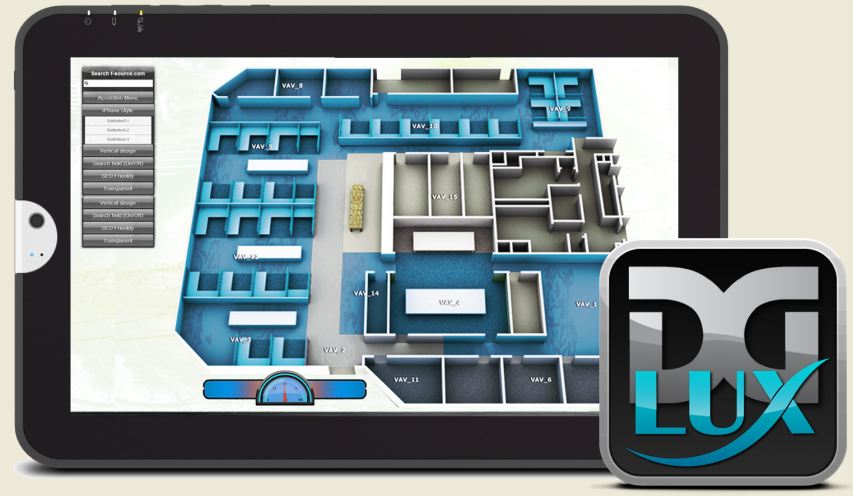|
February 2012
Interview
AutomatedBuildings.com
|
[an error occurred while processing this directive]
(Click
Message to Learn More)
|

EMAIL INTERVIEW
- Eugene Mazo, and Ken Sinclair
Eugene Mazo, CEO,
DGLogik Inc.
Visualization Platform
Build visually stunning interfaces
and dashboards without writing a single line of code.
Sinclair: Can you tell me a little bit about
DGLogik and your visualization platform - DGLux?
Mazo:
Sure, DGLogik is a company that creates technology for maximizing
data
usability through intelligent visualization. We believe that in order
for any audience to understand and be able to take quick actions and
make better decisions based on the sea of data they have at hand, a
visual story needs to be told. Our technology brings data to life
through effective visualization and allows you to tell thought
provoking, engaging stories.
DGLux, our flexible “Drag & Drop” visualization platform
enables
you to deliver a powerful story using real-time, data-driven dashboards
and user interfaces on web, desktop, and mobile. With this we have
removed the constraints of having to hire developers to write code. We
bridge the gap between designers and developers through a true visual
programming environment. This platform enables designers to take a
project from
inception to execution very quickly. Imagine interacting with an
application that looks and behaves exactly as it was intended to. This
is the power and flexibility that DGLux has been architected with from
the ground up. Now you can build visually stunning interfaces and
dashboards without ever writing a single line of code.
Sinclair:
What are the advantages of joining the functions of the designer and
developer through an intuitive, customizable visualization platform?
Mazo:
Through the “drag and drop” programming environment, anyone
can
easily create dashboards and applications. The “what you see is what
you get” visualization allows you to create user interfaces which
function exactly the way you intend them to. By significantly reducing
time and money spent on project design, creation, and deployment,
companies will save time and money in creating their own personal user
experiences.
Sinclair:
What is the importance of dashboards and visualization within the
building automation industry?
Mazo:
Ken, you always say that the building automation industry needs to make
“the invisible become visible” and that the sea of data, which our
buildings create, can become a powerful asset. Dashboards and
customized visualization is the solution for allowing management,
engineers, building operators, and executives to properly utilize
building systems data. It is proven that building performance
visualization enables better analysis, well informed decisions, and
lower costs.
We have taken this concept a step further, because we believe that
with
visualizing data, there is no “one-size-fits-all” solution. Different
data needs different ways of being presented in order to make the
biggest impact on the audience. This is what we have done, we have
given DGLux users the ability to visualize any type of data in any way,
without dictating one way or another like so many other solutions do.
Nobody knows your business like you do. You should have your data
clearly organized in a fashion which makes sense for your specific
goals.
With a customized GUI, you can interact with your building
intelligence
rendered with true-to-life graphics in a clearly understandable format.
By having a personalized analytics system, you can enhance energy
analysis, monitoring, troubleshooting, load shedding, property
management, and cost comparison. Through educational kiosk displays,
you can easily “tell your story” to the outsiders and showcase your
building efficiency. You can have this customized GUI for every
building, every device, all within minutes.

Sinclair:
So how do you differ from your competitors?
Mazo:
Ken, this is a question we get very often. One thing to keep in mind is
that DGLux is the most mature and sophisticated visualization
technology available on the market today. Through the years of
experience on real projects where it has been deployed, we have
implemented the richest set of functionality and workflows to assist
the integrators in saving time where it matters. We focus on the
functionality which will make designers and users more efficient
ten-fold rather than saving a couple of minutes here and there. We have
also removed the constraints of designers having only several options
for graphics in putting together their interfaces. DGLux is so dynamic
and customizable at the core, that imagination is the only constraint
you will ever face.
Sinclair:
We have noticed that DGLux has integrated with SkySpark, Schneider
Electric, Niagara, XML, CSV, JSON, Salesforce and many other data
providers. What are the advantages of linking multiple data providers
through a singular user interface?
Mazo:
By connecting disparate systems through a single interface, all of your
unorganized data is made available in one location. There is no longer
a need to log into one system to get your energy analytics results,
then log into another system to make adjustments to your HVAC and
lighting schedules, and log into yet another system to see the
financial impact of your BMS. You can now have a single point of entry
and easily derive context which allows you to be faster reacting and
make better-informed decisions. With a high end, visually stunning
interface you have the tools to get the most out of your building
automation solutions.
Sinclair:
Today 95 percent of mobile employees have smart phones, up from 85
percent in 2010, with 91 percent using their smart phones for work – a
26 percent rise compared to 2010. With DGLux now available for all
platforms including iOS and android, what do you feel the biggest
advantages are for the building automation systems becoming mobile?
Mazo:
Our fast lifestyle has forced mobile devices to become a primary source
of data consumption and task completion. We have developed native apps
for iOS, android, blackberry playbook, and Windows mobile devices which
all allow you to see your dashboards and application in the exact same
format across all mobile and desktop platforms. With the ability to
access your Building Management System (BMS) on the go, facility
managers and building owners have the power to take action and make
adjustments from anywhere in the world regardless of whether they are
sitting in the office in front of a computer or walking their dog in
the park. Imagine having the knowledge of your previous energy
consumption habits including historical perspective, the ability to
recognize problem areas immediately and the confidence in the optimal
deployment and utilization of your assets in a single mobile interface.
By linking all of your building automation systems into one mobile
interface, you can interact with and manage any asset (lighting, HVAC,
ect) through intuitive and simple to use controls tailored to your
deployment, policies and processes.

Sinclair:
What do you think the limitations of mobile BAS technology are? How do
you see BAS mobility effecting the future of the building automation
industry?
[an error occurred while processing this directive]
Mazo:
We believe that the current state of mobile technology is shattering
the previous limitations of accessibility and real time visualization.
To bring up a common example that we use, previously the only way to
get data from an intelligent device, such as a light switch, and do
some sort of analysis on it would be to export it out of a database
somewhere into a spreadsheet, create some simple formulas in cells, and
create a primitive graph that displays a somewhat meaningful visual
representation of your analysis results. Now, through realistic and
real-time visualization technologies such as DGLux, data from light
switches, among hundreds of other devices, can be analyzed immediately,
the devices can be turned on, up, down or off – through simple controls
at your fingertips. BAS mobility will revolutionize the way building
managers operate and conserve. I expect that once exposure of this
state-of-the-art mobile technology increases, all will embrace the
benefits of BAS visualization and mobile accessibility. Now, through
BAS Mobility, you can manage your assets from anywhere, at any time,
ensuring a level of involvement with your systems simply not achievable
before.
Cross platform BAS visualization technologies such as DGLux, will
change the way we analyze our data and monitor our building
intelligence. It is only a matter of time until this BAS mobility will
be implemented across all major building portfolios. Historically, the
Building Automation industry has not been able to take advantage of the
latest technological enhancements, especially when the enhancements
have anything to do with mobile. I strongly believe that this needs to
change, there is no reason not to keep up with the current technology
in the Building Automation industry and take advantage of mobile
flexibility. With mobile BAS technology available, you can now optimize
your building performance beyond any standards of the past.
Sinclair:
This has been great, I appreciate you doing an interview. I
look forward to seeing this technology continue to grow and develop
over the next couple of years.
Mazo:
Thank you, it’s been a pleasure! We will be in touch.
footer
[an error occurred while processing this directive]
[Click Banner To Learn More]
[Home Page] [The
Automator] [About] [Subscribe
] [Contact
Us]

